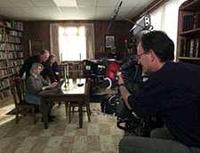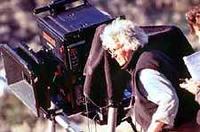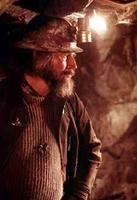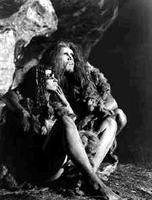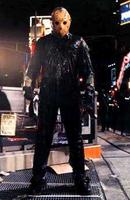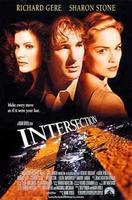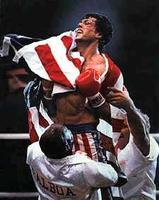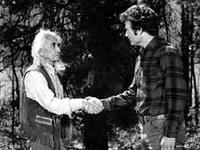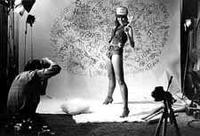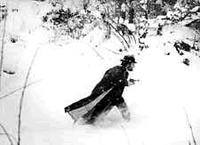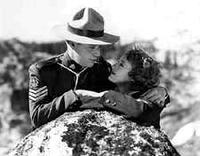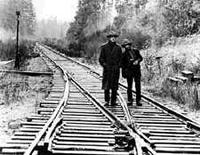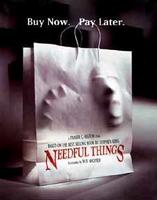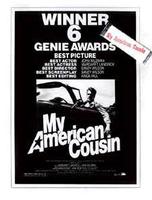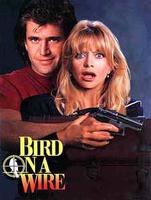Filmmaking Industry
FILMMAKING INDUSTRY has enjoyed such a boom in BC since the 1970s that the long-cherished dream of a "Hollywood North" has been realized in the form of Canada's largest feature film and television production centre. In 2017/18 the film industry generated direct spending of several billion dollars, the most of any province. A labour-intensive enterprise, the local industry accounted for 71,140 direct and spin-off jobs, again more than any other province.
Early Filmmaking, 1897–1936
BC's first recorded cinematic enterprise was the exhibition of a US prize fight film in Mar 1897, when viewers packed the Trilby Music Hall on Broad Street, VICTORIA, to watch Bob Fitzsimmons defeat Jim Corbett. In Oct 1902 Canada's first permanent movie house, the Electric Theatre, was opened by John Albert Schulberg, an itinerant showman, at 38 Cordova St in VANCOUVER. Its premiere attraction was Edison's Mount Pelée in Eruption.
Film realized its first commercial value as a promotional medium. To entice travellers to its Canadian destinations, the CPR became an advertising movie pioneer by producing the first film shot in BC: views of the ROCKY MTS filmed from the front of a CPR locomotive by Billy Bitzer, of the American Mutoscope and Biograph Company, in 1899. The railway also commissioned Warwick Trading Co, a British firm owned by Charles Urban, to produce films featuring BC scenery (1901) and US Edison Manufacturing Co to make a series of short travel comedies (1910). A CPR-sponsored travelogue was the first colour film shot in BC (1911). In 1908, the Urban company sent James Ferrens to shoot promotional films for BC's provincial government, which was the first in Canada to involve itself directly in movie sponsorship. The government took note of the exhibition business in 1913: it enacted the BC Motion Picture Act and established a Board of Censorship of Theatres and Film with C.L. Gordon, a former newspaperman, as its chief censor. In 1920, following Ottawa's creation of the Exhibits and Publicity Bureau—the world's first government film unit—BC set up its own production unit, the BC Patriotic and Educational Picture Service (PEPS). Exhibitors protested when it took the politically controversial step of imposing a quota, requiring cinemas to show 15 minutes of PEPS films every day. Although it existed in law until 1970, little funding and less enforcement effectively dispatched PEPS by 1925.
Coincidentally, the consolidation of Canada's exhibition business in US hands also began in 1920. In Jan of that year, with the incorporation of Famous Players Canadian Corp, the US film mogul Adolf Zukor established a theatre chain to show the features made by his Famous Players (later Paramount Pictures) production company. In Feb 1920 it acquired its first 2 BC cinemas, and by 1926 it dominated the market. US producers began shooting features on BC locations in 1921 with The Conflict and continued with a series of films shot throughout the 1920s, films that were assured theatrical bookings. There was no such assurance for Canadian producers, as the story of A.D. (Cowboy) KEAN illustrates. Kean became the first British Columbian to be known as a filmmaker. He incorporated Kean's Canada Films in 1915 to produce newsreels, but when theatres refused to book them he turned to industrial films. In 1920 he became chief cameraman for PEPS. He then returned to private production and in 1927 completed Policing the Plains, a feature-length romance paying tribute to the North West Mounted Police, but was unsuccessful in his efforts to have it distributed. Kean was in debt when he finally left the film business, which was institutionally inhospitable to Canadians.
In Dec 1927 the British Parliament adopted the British Cinematograph Films Act, which had a significant impact on BC filmmaking. Designed to protect the UK's indigenous film industry from US predation by imposing a quota on exhibitors, the Act generously defined Commonwealth-produced films as British. In July 1932 the British-born Kenneth BISHOP responded to this incentive by incorporating Commonwealth Productions Ltd in Victoria. With the backing of Kathleen Dunsmuir Humphries, an OAK BAY heiress with acting ambitions, Bishop leased studio space at Willows Park and produced BC's first sound feature, The Crimson Paradise. Although Victoria society turned out for the film's premiere in Dec 1933, Bishop was not able to find a distributor for his picture and Commonwealth went broke before completing its second feature. With the backing of Columbia Pictures, Bishop rebounded to form Central Films in 1935, producing 12 low-budget "quota quickies" in 3 years. His efforts did not go unnoticed: in 1938 Britain revised its legislation to exclude such Hollywood-backdoor products.
In Apr 1931 the report of the White inquiry, An Investigation into an Alleged Combine in the Motion Picture Industry in Canada, was released. The federal royal commission had heard months of testimony from Canadian film professionals and had found that "a combine exists...and has existed since the year 1926," and that 2 US companies, Famous Players Canadian Corp and Motion Picture Distributors and Exhibitors of Canada, controlled the Canadian film market. Encouraged by White's findings, Ontario, BC, Alberta and Saskatchewan charged 15 distribution companies with offences under the Combines Investigation Act. In 1932, following a 6-month trial, the Ontario Supreme Court upheld the status quo by finding the defendants not guilty. That same year BC amended its Moving Pictures Act to give the government power to implement a quota system for films "of British manufacture," but the power was never used, and the amendment was quietly dropped from the Act in 1971. It was business as usual in 1936, the year the Vancouver Film Society was founded and the Gaumont British Company went on location in REVELSTOKE to film Silent Barriers, the story of the building of the CPR.
BC filmmakers who were excluded from theatrical feature production, including Leon Shelley and others, created a regional industry based on documentaries and sponsored short subjects. The pattern of government agencies taking responsibility for a significant portion of production in the province was set in 1939 when BC's Government Travel Bureau established a Photographic Branch and the federal government set up the National Film Board of Canada. Both generated commissions for Shelley's company, Vancouver Motion Pictures Ltd.
In Apr 1941 a new force in the exhibition business made its debut in Vancouver, when N.L. Nathanson, former managing director of Famous Players, opened the Vogue Theatre. It was the first link in his new Odeon Theatres chain, a circuit that Britain's Rank Organization acquired in 1946. By that time BC filmmakers were optimistic. Jack Bowdery of Vancouver identified a market niche in the network of 16mm cinemas that had grown during the war years. He formed North American Pictures and produced 4 short features before his market disappeared. In expectation of a post-war film boom, Leon Shelley relocated to Toronto; his production manager, Lew Parry, stayed in BC and founded Trans-Canada Films (1946), then sold it to Don Coltman and Wally Hamilton (1948). Lew Parry Productions was formed when Parry bought out North American Productions (1948), and the company remained the core of BC's commercial film community into the 1960s. Economists predicted that Ottawa would impose a quota on US films to stem the alarming flow of dollars out of the country. Instead, in Jan 1948, federal officials sat down to lunch with US film industry lobbyists and signed on to the Canadian Co-operation Project—essentially a promise by Hollywood studios to include more references to Canada in their films.
Rise of the Modern Industry, 1955–80
Television changed the economic and social dynamic of the film industry. CBUT, the Vancouver CBC-TV station, went on the air in Dec 1953. Its 16mm Film Unit, whose members included Stan Fox, Allan King, Daryl DUKE and Ron Kelly, helped shape BC's sense of itself as a creative centre. CBUT documentaries such as King's Skidrow (1957) were recognized nationally for their excellence. CARIBOO COUNTRY, a teleplay produced in 1958, evolved into a mini-series (1960), then a full series (1963). By 1962 the CBC was operating 6 stations in BC. When the privately owned CHAN-TV (later BCTV) went on the air in Oct 1960, its main competition was the border station KVOS, located in Bellingham, WA. KVOS had been on the air since June 1953 and Vancouver was its major market. To serve its commercial clients it established offices on Burrard St and its film unit, set up in 1960 under Jack Gettles and Vic Spooner, became Canawest Film Productions in 1963. By 1965 its Vancouver animation studio was a major subcontractor for Hanna-Barbera in the production of television cartoon series. Canawest incorporated as an independent company in 1967. The broadcasters brought a sense of new opportunity to the market that was reflected in Lew Parry's decision to build a $100,000 studio in N VANCOUVER for his Parry Film Productions (1956). When Oldrich Vaclavek founded Panorama Productions Ltd to make feature films (1956), his initiative resulted in the construction in 1961 of Panorama Studios (later Hollyburn Film Studios) in W VANCOUVER. In 1958, a year after the creation of the Canada Council for the Arts, Al Sens set up BC's first animation studio. The theatrical exhibitions mix was enriched by the founding of the original VANCOUVER INTERNATIONAL FILM FESTIVAL, and in 1962 the regional office of Odeon Theatres organized the first Varsity Festival of International Films, a 2-week foreign-film showcase that ran annually until 1982. In expectation of feature productions, Local 891 (motion picture production technicians) of the International Alliance of Theatrical Stage Employees (IATSE) was chartered in 1962, the year James Clavell directed The Sweet and the Bitter, Vancouver's first sound-era feature, for Vaclavek's much-restructured Commonwealth Films. At UBC, where the CBC's Stan Fox had conducted production workshops, the student film society supported one of their own, Larry KENT, in the making of 3 low-budget features: Bitter Ash (1963), Sweet Substitute (1964) and When Tomorrow Dies (1965). The National Film Board, perhaps recalling that the Vancouver-made Herring Hunt had been a 1953 Academy Award nominee, opened its first regional production office in Vancouver in 1965. The BC Film Industry Association, founded in the same year, saw renewed hope for BC filmmaking in the Anglo-Canadian co-production The Trap (1965), the American director Robert Altman's "discovery" of Vancouver with That Cold Day in the Park (1967), and the CBC's first made-for-TV movie, Waiting for Caroline (1967).
In Feb 1968, Bill C-204 created the Canadian Film Development Corporation (renamed Telefilm Canada in 1984). Although its mandate was to "foster and promote the development of a feature film industry," it favoured Montreal and Toronto as production centres, offering only token support in other regions. The policy was made explicit in 1972 by its first director, Michael Spencer: "Vancouver is never going to be the Hollywood of Canada and although there will likely be films made here, hopes are dim that BC will ever have what can be called a feature film industry." Undeterred, independent filmmakers from the student and fine arts communities—Jack DARCUS, Tom Shandel, Byron Black, Boon Collins, Peter Bryant—all completed features. In 1972, Pacific Cinematheque was established to promote and exhibit non-commercial films. The CBC created BEACHCOMBERS, an international hit series (1972–89), and the service industry attracted US projects such as Bob Rafelson's Five Easy Pieces (1969), Altman's McCabe and Mrs Miller (1970) and Mike Nichols's Carnal Knowledge (1971).
Having produced The Groundstar Conspiracy (1972) on location for Universal, the British-born studio executive Trevor Wallace formed his own BC-based company and made the features Christina (1974) and Journey into Fear (1975). The Canadian government amended the Income Tax Act in 1974 to offer a 100% Capital Cost Allowance (CCA) for "certified feature films," and the emphasis shifted from domestic directors to producers. The tax-shelter production boom that followed (1977–81) occurred largely in Toronto and Montreal. The single significant BC beneficiary was the award-winning documentary director Phil BORSOS, whose superlative feature debut, The Grey Fox (1982), was his ticket to a Hollywood career.
In 1975 BC's animation community grew with the addition of Marv Newland's International Rocketship studio. Also in 1975 the federal government made a timid attempt to deal with the long-standing question of exhibition: it negotiated a "voluntary quota" agreement with Famous Players and Odeon Theatres, who agreed to play Canadian films in each of their cinemas for a minimum of 4 weeks a year. The plan was quietly abandoned 2 years later, just as the era of the multiplex arrived with the opening of Famous Players' Capitol 6 on Granville Street in downtown Vancouver. In July 1975 the BC Film Industry Association recognized the need for more local initiatives and petitioned Victoria to establish an office to promote the industry. In Aug 1977 Wolfgang Richter was hired to head a BC Film Promotion Office (later BC FILM COMMISSION).
Hollywood North
By the late 1970s all the important infrastructure was in place for an industry to provide full-service location support. The Canadian dollar had begun a decline that would reach 72 cents US in 1986—an economic reality that made it possible for US producers working in BC to realize irresistible savings. A significant increase in the production of features, TV movies, series pilots and series episodes created the need for new facilities. In 1981 a Dominion Bridge Co building in Burnaby was pressed into service as a movie sound stage for the Charlton Heston feature Mother Lode. It remained busy and opened officially as the provincially owned Bridge Studios in 1987, the same year Stephen Cannell brought his 3 television series—Wiseguy, JJ Starbuck and 21 Jump Street—to BC. In 1989, together with Paul Bronfman, Cannell built the North Shore Studios (renamed Lions Gate Studios in 1997) in N Vancouver. The growth of the service sector was reflected in an annual industry directory, The Reel West Film and Video Digest, first issued in 1980. Its publishers, Sandy Flanagan and Martin Borycki, spun off the bimonthly Reel West Magazine in Apr 1985, and it became a vocal advocate for the BC industry. TV producers, meanwhile, were sufficiently impressed with BC to bring ever more sophisticated series into the province. By the mid-1990s, so many special-effects-dependent shows were based in Vancouver that BC became known as Hollyweird. The Vancouver International Film Festival, revived in 1982, added a Trade Forum in 1986, and a year later the privately owned Vancouver Film School opened. All of this activity contributed to the parallel growth of indigenous filmmaking. In 1987 the provincial government set up BC FILM, with Wayne Sterloff as president, to provide funding for local productions. Some BC-based producers, including Lloyd Simandl and James Shavick, prospered by making direct-to-video features. Others, including Peggy THOMPSON, Charles Wilkinson, Sandy WILSON and the fearless documentarian Nettie Wild, developed independent theatrical features. In 1991 John Pozer, a UBC film student, produced as his Master's thesis a feature film, The Grocer's Wife, that brought together Bruce Sweeney, Mina Shum, Kathy Garneau, Gregory Wild and Lynn Stopkewich, all of whom were also UBC film students and all of whom went on to direct their own features. The visibility of filmed-in-BC TV shows such as X-FILES (1993–97) and such blockbuster features as First Blood (1982), The Accused (1987), Legends of the Fall (1994) and Double Jeopardy (1999), have established BC as a major N American production centre, rivalling New York for the number 2 position (after Los Angeles).
by Michael Walsh

